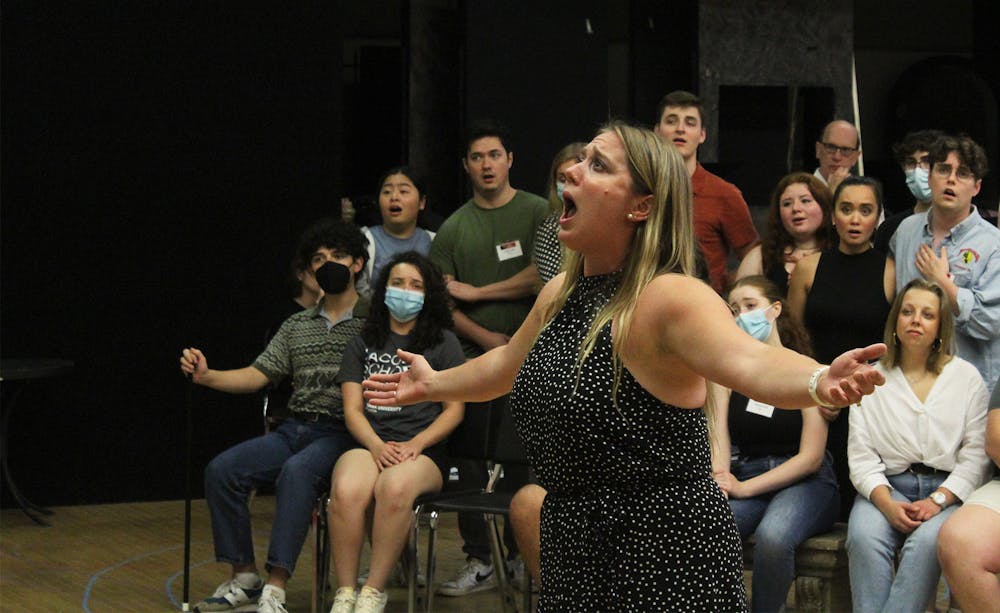The Jacobs School of Music Opera and Ballet Theater department will present the first opera of the fall season, “The Merry Widow,” with two casts at 7:30 p.m. Sept. 22 and 23 at the Musical Arts Center.
Student tickets are available for $10 at the Jacobs School of Music website.
The production will be directed by the sought-after and renowned director and movement coach, Keturah Stickann.
After serving as director and choreographer for the world premiere of “It’s a Wonderful Life” in 2017 with the Jacobs School of Music, Stickann returned to work on “The Merry Widow,” once again bringing her blend of movement and direction to the Musical Arts Center stage.
The Indiana Daily Student spoke with Stickann about her role as director of “The Merry Widow” on Sept. 13.
[RELATED: https://www.idsnews.com/article/2023/09/olivia-rodrigo-guts-album-review]
IDS: How did you get involved with “The Merry Widow” this year?
Stickann: I’d been here before and a couple of the people I’d worked with liked my work. I have a dance background, so because “The Merry Widow” has a lot of dance in it, they asked me to come on board.
IDS: This is your third time directing “The Merry Widow,” correct?
Stickann: First time directing but it’s my fourth time working on this production either as a choreographer or an assistant director. The more that I’ve worked on it and the deeper I’ve gotten, the more I see how intense the love story is between Danilo and Hanna — the two main characters. They snipe at each other and eventually get together in the end. When I choreographed it, I was only thinking about the dances the two of them had. But from a director’s point of view, there’s serious history between these two characters and a lot of pain. Watching their path of trying to get back together is a much deeper moment than I think we see on the surface.
[RELATED: https://www.idsnews.com/article/2023/09/iu-century-16-mm-film-jesse-eisenberg-andy-warhol]
IDS: How do you incorporate dancing with the singing?
Stickann: There’s a huge waltz number that takes place at the end of Act One and the entire chorus dances, which is difficult. There are always some people in the group with dance training but then there’s always other people who have never experienced that type of dance. Integrating dance like that is working to the lowest level of what people can do then slowly building it up when people get more and more confident. I’ve been very impressed with what our chorus and our principals have been able to do though. It feels very good.
IDS: How does your background in dance influence you as a director?
Stickann: Having a degree in choreography makes me look at the full stage space and look at the spatial relationships between everybody on stage. My creation of stage picture is something that I take very much from the notion of choreography, the idea of movement across a full space.
IDS: Could you expand on the idea of spatial relationships?
Stickann: It’s how far apart we are standing, what’s the balance of the stage, what does it look like when this group of people is on this side and this group of people is on the other side. Are we feeling a heaviness on one side versus the other? When you have two people arguing, how far apart do they need to be at any given moment based on how angry they are? It’s how we look at the space and how we look at the people inside that given space to determine storytelling based on where they’re placed.
IDS: Why is physicality important for you?
Stickann: “Park and bark” is this outdated notion in opera. The way we experience storytelling has changed over the years. Opera is theater, a different genre, but theater. To tell the story we need to not only use our voice but our bodies. This is the challenge that opera singers have; they have to be physical beings as well as vocal beings. I think that we are such visual people that it is important we tell the story from the voice and from the physicality.
[RELATED: https://www.idsnews.com/article/2023/09/nun-2-movie-review-conjuring]
IDS: You’ve been described as a “text-influenced” creator, could you speak to that more?
Stickann: It’s about storytelling. The text— especially in “Merry Widow” – it’s very much like a musical in that there’s more spoken dialogue than there is music, which is different. That’s a big challenge. But the text, the words, the beautiful sound coming out of our mouths is important because that’s what the ear wants to hear. When it comes to the storytelling, if we don’t chew the text, if we don’t know what it means, then the storytelling gets completely lost and we lose the thread of what’s happening character to character.
IDS: This opera is funny. It’s really funny. Could you speak to the notion some may have about operas being strictly serious?
Stickann: The physical comedy we put into it and the way we try to tell these jokes make it funny. People do have a notion that opera is very serious and that’s untrue, there are some incredibly funny operas out there and “Merry Widow” is one of them. It’s a light comedy and what we’ve put into it will speak for itself. Everyone is very funny up there, and I’m proud of what they’ve been able to achieve.
IDS: What makes these stories and this humor so timeless?
Stickann: Love is love is love, and money is money is money. Those are the two main themes in this piece. Fighting over money, fighting over a love affair, these things still happen today. We still yearn to be wealthy, we still yearn to be in love. These characters fighting, finding and repelling each other are universal things, we know, feel, and this is the relevance of opera. Ultimately love is what gives us an opera.




